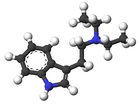Diethyltryptamine
This article's factual accuracy is disputed. (October 2011) |
 | |
 | |
| Clinical data | |
|---|---|
| ATC code |
|
| Legal status | |
| Legal status |
|
| Identifiers | |
| |
JSmol) | |
| Melting point | 169 to 171 °C (336 to 340 °F) |
| |
| |
| | |
DET, also known under its chemical name N,N-diethyltryptamine and as T-9,
Chemistry
DET is an analogue of the common tryptamine hallucinogen N,N-Dimethyltryptamine or DMT.
Pharmacology
This section needs additional citations for verification. (October 2013) |
The mechanism of action is thought to be serotonin receptor agonism, much like other classic psychedelics.[3]
DET is sometimes preferred over DMT because it can be taken orally, whereas DMT cannot. This is because the enzyme monoamine oxidase degrades DMT into an inactive compound before it is absorbed. To overcome this, it must be administered in a different manner, i.e. intravenously, intramuscularly, by inhalation, by insufflation, rectally, or by ingestion along with an inhibitor of monoamine oxidase. Because DET has ethyl groups attached to its nitrogen atom, monoamine oxidase is unable to degrade it. This is also true for many other tryptamines with larger nitrogen substituents.
Biochemistry
Although DET is a
Psychosis model
Early studies of DET as well as other psychedelics were focused on their presumed
Legal status
Internationally DET is a Schedule I drug under the Convention on Psychotropic Substances.[7]
Australia
DET is considered a Schedule 9 prohibited substance in Australia under the Poisons Standard (October 2015).[8] A Schedule 9 substance is a substance which may be abused or misused, the manufacture, possession, sale or use of which should be prohibited by law except when required for medical or scientific research, or for analytical, teaching or training purposes with approval of Commonwealth and/or State or Territory Health Authorities.
See also
- TiHKAL
- 5-MeO-DET
- 4-PO-DET (Ethocybin)
- Machine Elves
References
- ^ Anvisa (2023-07-24). "RDC Nº 804 - Listas de Substâncias Entorpecentes, Psicotrópicas, Precursoras e Outras sob Controle Especial" [Collegiate Board Resolution No. 804 - Lists of Narcotic, Psychotropic, Precursor, and Other Substances under Special Control] (in Brazilian Portuguese). Diário Oficial da União (published 2023-07-25). Archived from the original on 2023-08-27. Retrieved 2023-08-27.
- ^ "Erowid DET Vault : Chemistry". Retrieved 2008-01-08.
- PMID 5306645.
- S2CID 43308695.
- ^ Böszörmenyi Z (1960). "Psilocybin and diethyltryptamine: Two tryptamine hallucinogens". Neuro-psychopharm. 2: 226–9.
- PMID 5839429.
- ^ International Narcotics Control Board (August 2003). "List of psychotropic substances under international control" (PDF). Archived (PDF) from the original on 2 March 2007. Retrieved 30 March 2007.
- ^ "Poisons Standard". Federal Register of Legislation. Australian Government. October 2015.
